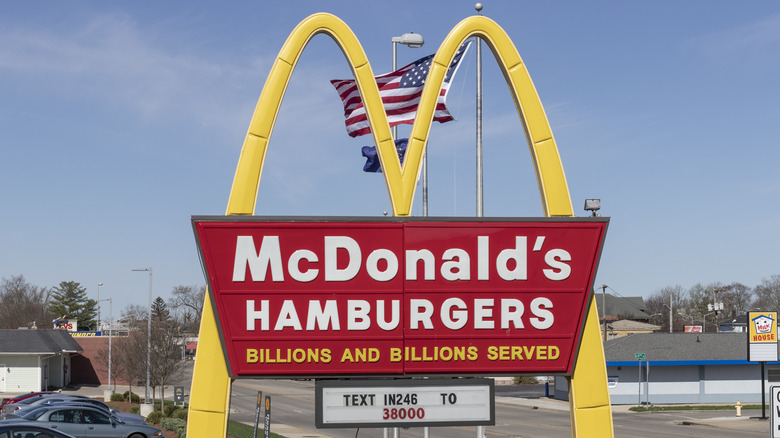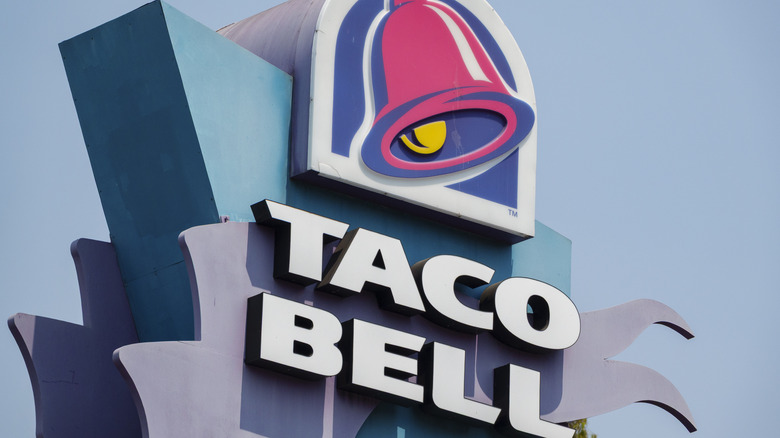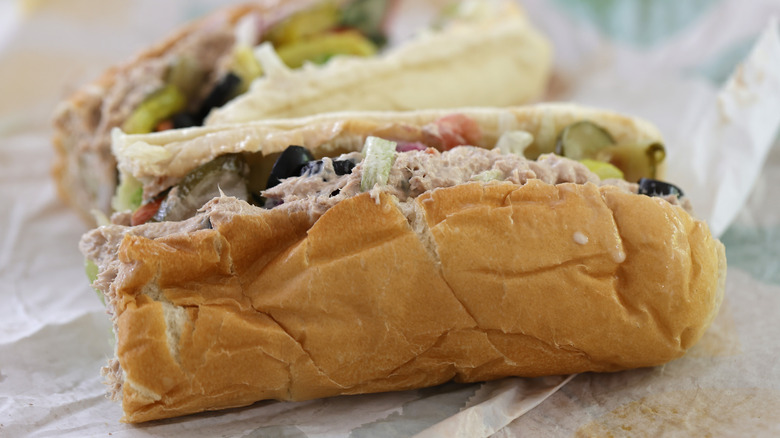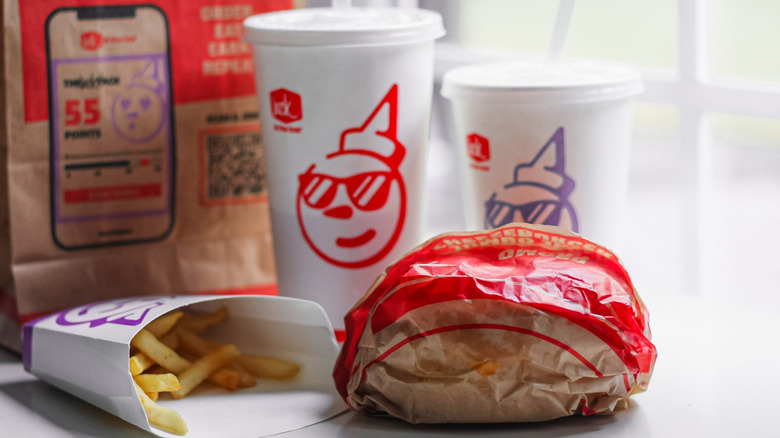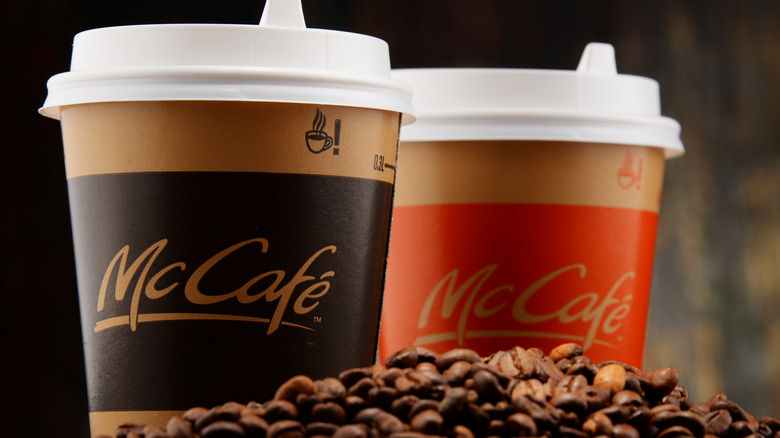Dark Histories Of American Chain Restaurants
There were more than 1 million restaurants in the U.S. as of 2025, and of that staggering volume of places to get a meal, a snack, and a drink, at least 14% belong to a chain. Despite the many disturbing fast food restaurant secrets and links to negative health effects that are constantly reported and right out in the open, many of us can't resist them. All those all-American chains became household names and billion-dollar companies because their products taste good, providing the delectably perfect amount of salt, sugar, fat, and comfort.
That makes the biggest fast food and casual restaurant chains very wealthy and very powerful, and sometimes they overstep or act dangerously in the name of just doing business. Here are some of the best-known and longest-lasting restaurant chains that keep serving customers despite some dark and shocking moments in their histories.
Taco Bell swiped its entire premise
The storied tale of Taco Bell, which includes the use of one of the most controversial corporate mascots in history, begins in 1962. That's when Glen Bell opened the first location in Downey, California, and it went on to become one of the first and most influential Mexican-inspired chains. That's in part because of the signature offering on what was a very limited menu: A hard-shell taco, made from a corn tortilla fried until crispy and then folded over and stuffed with seasoned beef, cheese, and lettuce.
Glen Bell didn't invent the Taco Bell twist on the taco. In 1937, Lucia Rodriguez, an immigrant from Jalisco, opened Mitla Café, a Mexican restaurant, in San Bernardino. Part of her repertoire was a mashed potato-filled hard-shell taco, and at her new shop, she changed the filling to ground beef, cheese, lettuce, and tomatoes. Those tacos made the restaurant extremely popular, which Bell noticed when he opened a hamburger and hot dog stand across the street in 1948. He added Mexican food to his offerings, and much later to the first Taco Bell menu, lifting the idea entirely from Mitla Café. "I remember him," Rodriguez's daughter-in-law recalled of a '60s-era Bell in Gustavo Arellano's "Taco USA," adding that he "used to come in late at night, ask lots of questions about how we made tacos, and then leave."
Subway's bread, chicken, and tuna was heavily questioned
Subway boasts the most domestic locations of any food chain, with more than 20,000 sandwich shops across the United States. By the mid-2010s, the public started wondering how the restaurant could churn out so much product. It turned out that Subway utilized a lot of chemicals — as well as some tactics that are still shrouded in mystery — to build its sandwiches.
In 2014, influencer Food Babe started a viral campaign to urge Subway to remove purportedly harmful chemicals from its bread, namely the additive azodicarbonamide. Used to fortify and thicken dough, it's approved by the FDA in the U.S. but is an illegal ingredient in Australia and the European Union, as it can break down into the cancer-linked urethane. It's also used in shoe soles and yoga mats to make those products more elastic. Subway caved to public pressure and promised to stop using azodicarbonamide.
Three years later, Subway faced allegations that its chicken wasn't totally chicken. "CBC Marketplace" and Trent University tested samples from Subway, revealing that the protein was half poultry and half soy. The chain's own tests proved it was selling mostly chicken, and it filed a $210 million defamation suit against the CBC, which was later dismissed. In other Subway legal news, in 2021, the chain faced another lawsuit over the veracity of its tuna. A New York Times reporter had the Subway tuna salad tested, and the results showed 0% tuna DNA. The case was dismissed in 2023.
Jack in the Box's burgers killed people
In 1993, employees at the Washington State Department of Health noticed a sharp rise in cases of hemolytic uremic syndrome among children in Seattle. Victims experienced symptoms like bloody diarrhea, and they'd all eaten a hamburger from Jack in the Box. The cause of HUS: E. coli, a food-borne bacteria that can thrive in undercooked beef, and it was linked to the fast food chain.
And that was just the beginning of a tragic sequence of events. Within a month, more than 700 people from Idaho, Nevada, and California who had consumed a Jack in the Box burger all registered E. coli infections and reported severe symptoms. Four of those people died as a result, and they were all children, who are generally more susceptible to the deleterious effects of the bacteria.
The ensuing federal investigation pointed to six Von Corporation slaughterhouses, contracted as Jack in the Box suppliers, as the locations where E. coli infected the meat. However, cooking burgers to an internal temperature of 155 degrees Fahrenheit can kill off even dangerous bacteria. Different public health agencies had previously told Jack in the Box to ensure that its outlets adopted that procedure. The restaurant hadn't done that, often operating with a goal temperature of 140 degrees Fahrenheit — sometimes cooking them at lower temperatures — to soften the meat. After the outbreak, Jack in the Box's sales fell by up to 35%.
Denny's has been repeatedly accused of racism
Denny's harkens back to a bygone American era. If you stop by any one of its 1,300-plus locations, you'll find low prices on familiar favorites like breakfast platters, burgers, and bottomless cups of coffee served around the clock. Unfortunately, on several occasions, the chain also alluded to another long-gone period of history: When segregation and refusing service to people of color was common and permitted.
In 1993, six Black members of the Secret Service were denied service at a Denny's restaurant. When a discrimination lawsuit was filed, it garnered substantial media attention, as did Denny's agreeing to pay out $54 million in 1994 to the plaintiffs in several other, unrelated cases of racially based mistreatment at other company restaurants. And then in 2012, two Black customers who tried to dine at a Wendy's were told they had to pay before service. It was not a company policy but something that the management of that Denny's instituted because other Black customers had allegedly left without paying in the past. As recently as 2023, a video of two Black men being refused service at a South Dakota Denny's went viral. The chain said it would launch an internal investigation.
McDonald's has a cutthroat courtroom approach
Among the many shady secrets McDonald's doesn't want its customers to know about is how it has spent a lot of time and money on court cases defending its questionable practices. In 1992, 79-year-old Stella Liebeck hit a McDonald's drive-through lane in Albuquerque for a cup of coffee. When she tried to pry open the lid to cool down the piping hot beverage with a bit of creamer, it spilled and fell all over the lower part of her body. The sweatpants Liebeck was wearing provided little in the way of protection, and she was hospitalized for third-degree burns over 16% of her body. In some spots, the coffee had caused the skin to totally burn off. Liebeck spent eight days under medical care, recovering from the burns and skin graft surgery.
Liebeck sued McDonald's for $20,000 to pay for medical costs and the income she lost because she was unable to work while she recovered. McDonald's offered to settle for $800, so she took the matter to court, where a jury awarded her nearly $3 million in compensatory and punitive damages. The judge reduced punitive damages to $480,000, and McDonald's settled with Liebeck privately for an unknown amount. During the proceedings, it emerged that McDonald's required affiliates to serve coffee at the dangerously high temperature of 185 degrees Fahrenheit, or near boiling. The case also revealed that in the 10 years before the Liebeck incident, the company had fielded 700 complaints from customers who'd been burned by the stuff.
